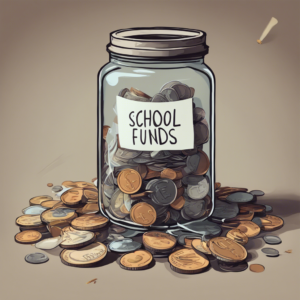Every morning as I walk through the doors of my classroom, I can feel the weight of our school’s challenges. Teaching in a Title I school has always been demanding, but recent years have brought an unrelenting set of pressures that test even the most dedicated educators. This isn’t a story of triumph over adversity—it’s a raw and honest account of the daily reality of working in an underfunded, overwhelmed system.
What is a Title I School?
 A Title I school is one that receives federal funding through the Elementary and Secondary Education Act (ESEA) to support the education of students from low-income families. The goal of Title I is to ensure that all children, regardless of their economic background, have the opportunity to receive a high-quality education. These schools typically have higher percentages of students who come from low-income households and may face additional challenges such as language barriers, special education needs, or behavioral issues. Title I funding is used to provide additional resources, support staff, and services to help students succeed academically, but unfortunately, it often falls short due to chronic underfunding.
A Title I school is one that receives federal funding through the Elementary and Secondary Education Act (ESEA) to support the education of students from low-income families. The goal of Title I is to ensure that all children, regardless of their economic background, have the opportunity to receive a high-quality education. These schools typically have higher percentages of students who come from low-income households and may face additional challenges such as language barriers, special education needs, or behavioral issues. Title I funding is used to provide additional resources, support staff, and services to help students succeed academically, but unfortunately, it often falls short due to chronic underfunding.
A System Under Strain
The special education department at our school is operating beyond its limits. With a large population of students who require specialized support, our staff simply can’t meet the growing demand. Special education teachers are overwhelmed by caseloads that are far too large, and unfortunately, many students who need services are left without the help they desperately need. General education teachers, despite their best efforts, are often expected to address complex special education needs, but without sufficient training or resources. The paperwork required to comply with Individualized Education Plans (IEPs) further strains our already limited time, taking away from the time we could spend supporting our students directly.
The Language Barrier Crisis
Our school’s language support system is painfully inadequate. While some schools benefit from robust ESL (English as a Second Language) programs, we do not have the luxury of such resources. Our students come from a wide range of linguistic backgrounds, including Spanish-speaking countries, Russia, and Ukraine. Each group has its own unique needs, and our minimal ESL support simply isn’t enough to bridge the gap. Without dedicated ESL teachers for most of the day, many of us are left to navigate language barriers on our own. We rely heavily on translation apps, but even these tools can only do so much. In many cases, students are acting as translators for their peers, but this often leads to important information being lost in translation. Parents, too, find it difficult to engage fully in their children’s education because of these barriers, creating further challenges in building a strong school-community connection.
Growing Class Sizes, Shrinking Staff
The situation continues to deteriorate as class sizes grow and staff numbers dwindle. Each semester, we see more students entering our classrooms without the necessary resources to meet their needs. Teachers leave, but the vacancies are rarely filled, leaving the remaining staff to handle larger, more diverse classes with fewer planning periods. The demands of covering additional classes and managing overcrowded rooms are taking a toll on both students and staff. Behavioral issues are becoming more frequent as a result of overcrowding, and students who require more individualized attention are increasingly being neglected.
A Community in Transition
The changes we are experiencing in our school are a reflection of the broader challenges facing our community. The surrounding area has seen a rise in violence, and just recently, we tragically lost a student to community violence. The tension and fear that these events bring are palpable in our classrooms. With more lockdown drills and security measures in place, students are entering the classroom carrying the heavy weight of trauma. In addition, families are frequently moving in and out of the district, often fleeing dangerous or unsafe situations, further contributing to the instability within the school.
The Daily Reality
While our school provides basic services such as free meals and 1:1 devices, these offerings can only address the surface-level needs. The deeper, systemic issues remain unaddressed, leaving teachers to shoulder the burden. We are constantly facing the emotional and physical toll of an impossible workload. Teachers are taking work home every night, but even then, it feels like we are never caught up. Students act out due to the lack of support, and parents express frustration at the challenges their children are facing, but there is little we can do to offer a solution. Our staff meetings often feel like a repetitive cycle, where the same problems are discussed but never truly addressed.
Attempting Solutions with Limited Resources
Despite the overwhelming challenges, we continue to search for solutions, though our options are severely limited. We share the few resources we have and make use of whatever tools are available, including translation apps like Google Translate, even though they are far from perfect. We lean on one another, creating makeshift support systems among colleagues, and often reach out to community organizations for assistance. When it comes to communicating with non-English-speaking families, we have to be resourceful and creative, doing the best we can with the resources at our disposal.
The Harsh Reality of Limited Support
Even though our school receives federal Title I funding, the reality is that we are chronically underfunded. Essential positions remain unfilled, special education resources are minimal, and the support for English language learners is inadequate. Our classrooms are overcrowded, facilities are aging and in need of repairs, and we have limited access to mental health services for both students and staff. These shortcomings are not just an inconvenience—they are barriers that prevent our students from receiving the education they deserve.
Impact on Education
The consequences of these challenges are deeply concerning. As the academic gaps between students widen, frustration and disengagement grow. Teachers are burning out, struggling to meet the needs of an ever-growing and diverse student body. Behavioral issues continue to rise, and staff morale continues to decline. Most concerning of all is the widening achievement gap, which only seems to grow more pronounced as resources dwindle.
Looking Forward with Uncertainty
While we hold onto hope that things will improve, we must also acknowledge the harsh reality of our situation. The strain on special education resources shows no signs of abating, and the need for language support continues to grow. Safety concerns, both in and around the school, are a constant worry. Staff retention remains a challenge, with many teachers feeling overwhelmed and unsupported. And, as always, we are being asked to do more with fewer resources.
This is not a story with a neat, inspiring ending. It’s a reflection of the ongoing struggle within a system that is simply not working for our students, despite the best efforts of the educators who care deeply for them. Our students deserve better—they deserve adequate special education support, proper language services, reasonable class sizes, and a safe, nurturing learning environment. Until these fundamental needs are met, the same challenges, frustrations, and missed opportunities will persist.
The dedication of our teachers and staff remains unwavering, but we know that dedication alone cannot solve the systemic problems that plague our schools. As we look to the future, it’s critical that we advocate for real change—change that includes adequate funding, appropriate staffing, and the resources our students need and deserve. Until that happens, we will continue to do our best, but we also have to admit that, under these circumstances, our best often falls short of what our students truly need.








